Athena Review Vol. 5, no. 1
Records of Life: Fossils as Original Sources
34. Early Primates: Eocene Adapids and Omomyids
Old World Eocene Adapidae
The first fossil primate described was a badly crushed skull of the Late Eocene adapiform Adapis parisiensis, found in the Paris Basin, and at first viewed by French naturalist Georges Cuvier in 1822 in his Reserches sur les Ossemens Fossiles as a member of a now obsolete rabbit-like group called pachyde
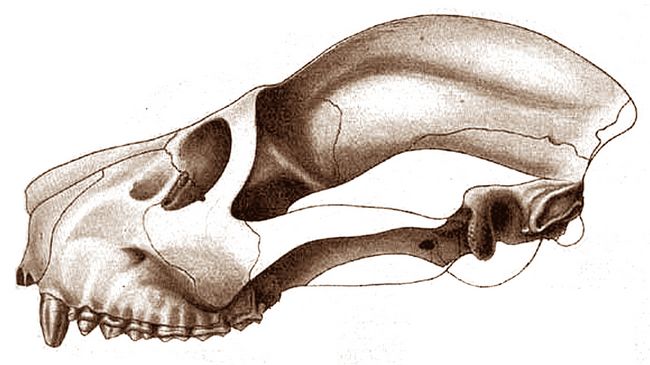 rms. Adapis was later correctly identified as a lemur-like primate by Delfortrie in 1873 (Gingerich 1975). The next year Filhol (1874) described the larger skull of a second species, Adapis magnus
(fig.1), found during 19th century phosphate mining activities in
South-central France, in Late Eocene (Priabonian stage)
paleokarstic deposits
(Godinot, 1984; Bernardi and Couette 2017). Well‐preserved crania and
mandibles of Adapis magnus recovered from these mines were described by Stehlin (1912).
rms. Adapis was later correctly identified as a lemur-like primate by Delfortrie in 1873 (Gingerich 1975). The next year Filhol (1874) described the larger skull of a second species, Adapis magnus
(fig.1), found during 19th century phosphate mining activities in
South-central France, in Late Eocene (Priabonian stage)
paleokarstic deposits
(Godinot, 1984; Bernardi and Couette 2017). Well‐preserved crania and
mandibles of Adapis magnus recovered from these mines were described by Stehlin (1912).Fig.1: Skull of Adapis magnus (after Stehlin 1912, fig.277).
In the 1960s field work in the Quercy region added new fossils including teeth, cranial fragments, and postcranial bones (De Bonis, 1964). Related fossils were also found in England (Cray, 1973), Switzerland, and Spain. Closer examination of the fossil record, in the light of these findings, indicates much greater diversity within the genus Adapis than previously supposed (Bernhardi and Coutte 2017). Differences between large and small specimens have also been interpreted in terms of sexual dimorphism (Gingerich 1981).
Adapis parisiensis is considered a likely ancesor of Lemuriformes. A. parisiensis has a dental formula of 2:1:4:3, with broad, spatulate incisors, medium sized canines, and sharply crested molars (Gingerich 1975). While Adapis has four premolars, no living lemurs have more than three. Gingerich (1975) notes that loss of one or more premolars has occurred commonly in fossil lineages. The anterior dentition of A parisiensis is unique among Eocene lemuriform primates, in that the lower canines are reduced in size, and function as a unit with the lower incisors, which could have led to the characteristic dental configuration in lemurs and lorises of an incisor-canine dental scraper. Gingerich (1975) proposes that the use of anterior lower teeth to procure resin or bark by Adapis could have led to such a well-developed tooth scraper.
Leptadapis
Leptadapis magnus was an adapid primate, dating from the late Eocene to Early Oligocene period and found in France. The species, related to Adapis, was named by Gervias in 1876, based on a skull and mandible described in
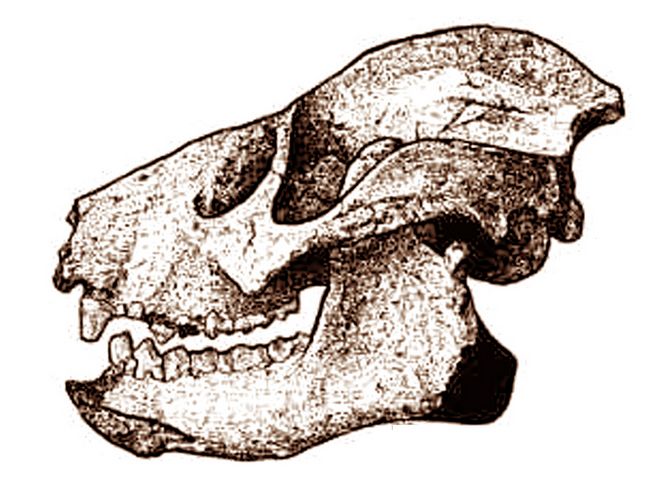 1874 by Filhol. Since then five additional species have been named.
1874 by Filhol. Since then five additional species have been named.Leptadapis magnus has a dental formula of 2:1:4:3 on both the upper and lower jaw. The canines of the lower jaw were well-developed, and the molars had high shearing crests. Based on dental morphology, it most likely had a folivorous diet (Fleagle, 1988).
Fig.2: Skull of Leptadapis magnus (after Piveteau 1957).
L. magnus had an average body mass of 4 kilograms. Based upon cranial and canine size, the species may have exhibited sexual dimorphism. The arm bones including the humerus are quite robust and suggest an active climber (Gebo 2002). Leptadapis magnus moved by quadrupedal climbing, and may have been diurnal (Fleagle, 1988).
Darwinius
Darwinius masillae is an Eocene adapiform primate represented by the fossil skeleton of a juvenile, who died at the margin of an ancent volcanic lake in a rain forest some 47 mya, and was preserved in Middle Eocene sediments at
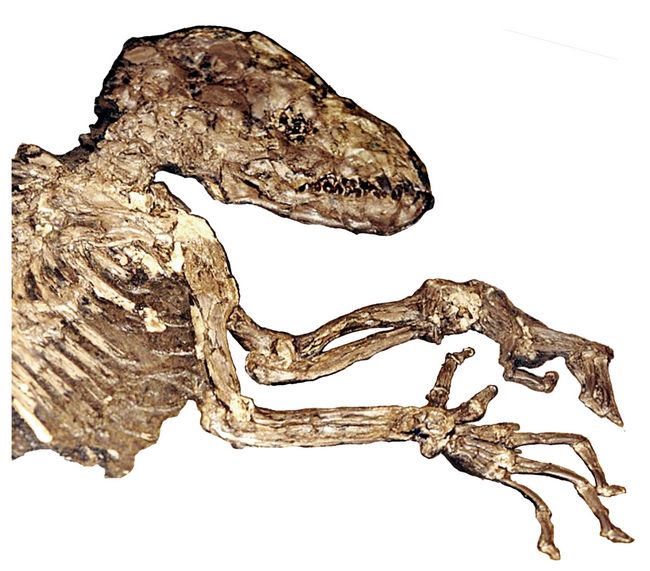 Messel, Germany. In the fine shale layer which yielded the fossil,
identified as that of a young female about 10-12 months old, traces of
soft tissue were also preserved. The fossil was found in 1983 by
private collectors who split the fossil into two parts. The fossil is
now reunited, and has been analyzed in detail by Franzen et al. (2009).
Messel, Germany. In the fine shale layer which yielded the fossil,
identified as that of a young female about 10-12 months old, traces of
soft tissue were also preserved. The fossil was found in 1983 by
private collectors who split the fossil into two parts. The fossil is
now reunited, and has been analyzed in detail by Franzen et al. (2009).Morphological traits preserved in Darwinius masillae (various aspects of skull, teeth, and limbs) enabled a lengthy comparison with the two principal subdivisions of living primates, Strepsirrhini and Haplorhini. This dichotomy, first made in 1812 by Saint-Hilaire, described Strepsirrhini as having a moist nose and median cleft in the upper lip, and include Indri, Lemur, Loris, Nycticebus, Galago, and Tarsius, all of whom have an extra membrane in the nose called the rhinarium which keeps it moist. Haplorhini ("simple noses"), by contrast, have a dry nose and continuous upper lip, and include Tarsioidea and Anthropoidea as suborders.
Fig.3: Part of the skeleton of Darwinius masillae (after Franzen et al. 2009)
Defining characters of Darwinius ally it with early haplorhines rather than strepsirrhines. This is somewhat surprising, since fossil adapiform taxa have heretofore been identified with lemur-like or strepsirrhine characteristics.
Darwinius masillae is considered important in being exceptionally well preserved, and providing a comparatively complete understanding of the paleobiology of an Eocene primate. Darwinius is not interpreted as an anthropoid, but the adapoid primates it represents, including Notharctus and Adapis, are seen to deserve more careful comparison with higher primates than they have received in the past. According to Franzen et al. (2009), Darwinius masillae, and adapidae contemporary with early tarsioids, could represent a stem group from which later anthropoid primates evolved.
Mahgarita
The adapid Mahgarita stevensi is described from finds in the late Eocene Duchesnean Laredo and Devil's Graveyard Formations of Texas by Wilson and Szlay (1976). The crushed skull of the type specimen is in the size range of a white-footed lemur (Lepilemur leucopus), and the most recent relative of the new form appears to be the middle Eocene European adapid Europolemur klatti from the Geiseltal region of Germany.
There are no indications that Mahgarita is closely related to the notharctine adapids. The new primate suggests that the Eocene of eastern North America was the homeland of lemuriforms with close European phylogenetic affinities. The posteriorly directed foramen magnum indicates a relatively small brain size and the dentition suggests an insectivorous-carnivorous dietary regime.
Omomyids
Omomyids are a group of early primates considered ancestral to tarsiers, one of the main branches of prosimians. Based on the makeup of their nostils, they are grouped in the suborder Haplorhini ("simple noses" ) as opposed to Strepsirrhini ("bent noses").
Omomyid fossils are widespread in the Late Paleocene through Eocene periods (59 to 34 mya), occuring in western North America, Europe, Asia, and possibly also the Fayum region of Egypt. Features that characterize omomyids such as Tetonius (fig.4) include large orbits or eye sockets (indicating noctural activities), shortened snouts or rostra and dental arcades, loss of anterior premolars, and cheek teeth with sharp cusps adapted for insectivorous or frugivorous diets.
Such skull and dentition features are consistently contr
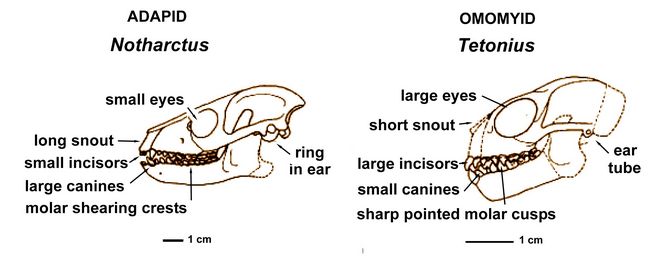 astive with most adapids, such as Notharctus
(fig.3). For example, two of the most diagnostic differences between
Eocene Adapids and Omomyids are the relative size and shape of lower
incisors. All adapids had incisors with spatulate crowns, and central
incisors smaller than lateral ones. All omomyids had incisors with
pointed crown, and central incisors the same size or larger than lateral
ones (Gingerich 1977).
astive with most adapids, such as Notharctus
(fig.3). For example, two of the most diagnostic differences between
Eocene Adapids and Omomyids are the relative size and shape of lower
incisors. All adapids had incisors with spatulate crowns, and central
incisors smaller than lateral ones. All omomyids had incisors with
pointed crown, and central incisors the same size or larger than lateral
ones (Gingerich 1977).Fig.4 Contrastive features of the crania and teeth of Adapids and Omomyids, shown by Notharctus (left) and Tetonius (right) (After Fleagle 1988).
Like today's primates, omomyids had grasping hands and feet with digits tipped by nails instead of claws, and probably lived in trees. Opinion remains very mixed as to whether Omomyids or Adapids were the ancestors of anthropoids, and what shared ancestral traits the two groups possess. Gingerich (1977) proposed that Omomyids may have evolved from Plesiadapiformes in the Paleocene, and that omomyids and adapids are parts of a single adaptive radiation.
Teilhardina
Teilhardina belgica was an tiny, marmoset-like primate classed as an omomyid that lived in Europe, North America and Asia during the Early Eocene epoch, about 55-47 million years ago. G.G.Simpson (1940) named this primate Teilhardina after the French paleontologist and philospher Teilhard de Chardin, who in 1927 first described the Belgian primate as a new species of Omomys.
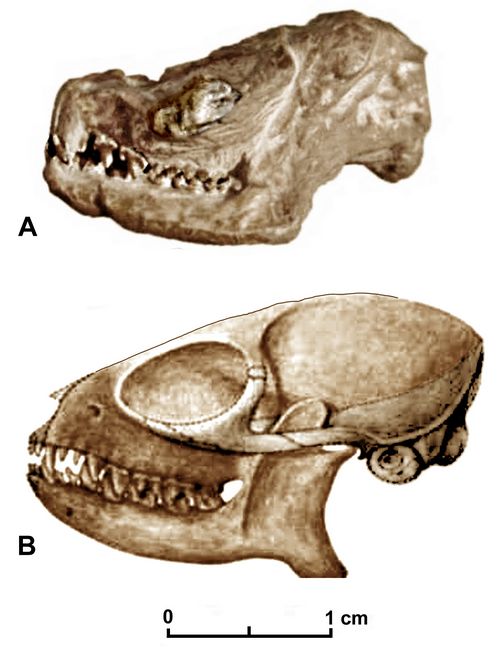 Gingerich (1977) discusses variation in the dentition of Teilhardina belgica. Like other omomyids, T. belgica had incisors with
pointed crown, and central incisors the same size or larger than lateral
ones. Some examples of T. belgica
had two incisors, a canine, three premolars, and three molars, while
other individuals had four premolars (i.e., 2:1:3:3 vs. 2:1:4:3
dentition formulas).
Gingerich (1977) discusses variation in the dentition of Teilhardina belgica. Like other omomyids, T. belgica had incisors with
pointed crown, and central incisors the same size or larger than lateral
ones. Some examples of T. belgica
had two incisors, a canine, three premolars, and three molars, while
other individuals had four premolars (i.e., 2:1:3:3 vs. 2:1:4:3
dentition formulas). The north American species, Teilhardina magnoliana, was discovered as a collection of tooth and jaw fragments in the Upper Tuscahoma Formation in the Gulf coastal plain of Mississippi. K. C. Beard (2008) proposed that this represents a very early primate that crossed the land bridge from Siberia to the Americas more than 55.8 million years ago, making it the oldest known euprimate in North America. This age estimate by Beard (2008) is based on a typology of three dinoflagellate species contained in the sandy soil matrix deposit containing the primate fossil bones. Its accuracy has been contested by Gingerich et al. (2008), who refer to their paper (Smith et al. 2006) for an alternative chronology based on Paleocene-Early Eocene Thermal Maximum conditions.
Fig.5: Skull of Teilhardina asiatica. A: fossil skull; B: reconstruction (after Ni et al. 2004).
Teilhardina asiatica, the first Teilhardina fossil found in Asia, is represented by a partially preserved skull (fig.5) from China with nearly complete upper and lower dentition (Ni et al. 2004). This was discovered in the upper section of Lingcha Formation in Hunan Province, with an estimated age of 54.97 mya. Nil at al. (2004) propose this as the most primitive species of Teilhardina, which would indicate that that the last common ancestor of euprimates was probably a small, diurnal, visually oriented predator.
Tetonius
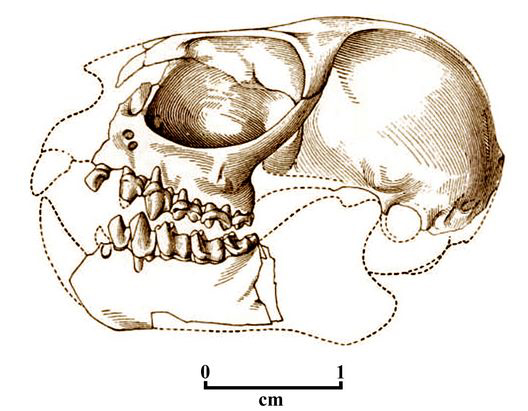 Tetonius homunculus (figs.6,7) was a omomyid
primate, dating from the early Eocene period and found in Wyoming. This species was very small, with an average
body mass of about 290 grams. It has a short snout, with large eyes
suggesting it was nocturnal (Fleagle, 1988). Based on dental
morphology, this species probably had a insectivorous diet. It had a
dental formula of 2:1:3:3 on both the upper and lower jaw.
Tetonius homunculus (figs.6,7) was a omomyid
primate, dating from the early Eocene period and found in Wyoming. This species was very small, with an average
body mass of about 290 grams. It has a short snout, with large eyes
suggesting it was nocturnal (Fleagle, 1988). Based on dental
morphology, this species probably had a insectivorous diet. It had a
dental formula of 2:1:3:3 on both the upper and lower jaw.Fig.6: Skull of Tetonius homunc
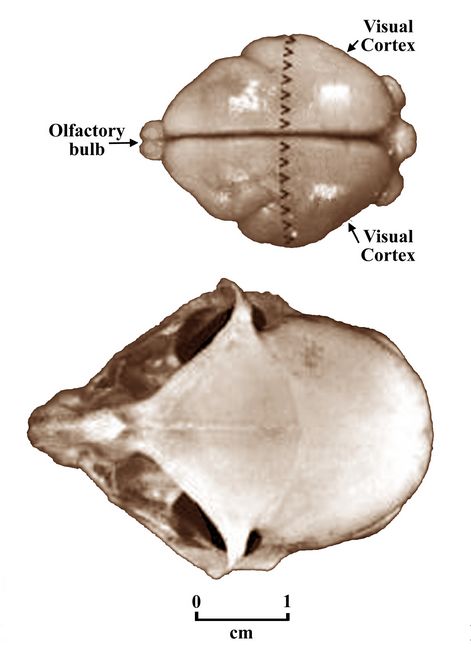 ulus (after Fleagle 1988).
ulus (after Fleagle 1988).As shown in fig.6, several traits of the skull are diagnostic of Omomyids such as Tetonius. This includes large eyes, an ear tube, a relatively short snout or nasal projection, large incisors, small canines, and sharp pointed molar cusps which are typical of an nsectvorous diet.
The cranial capacity of this tiny species (fig.7) was 1.5 cc, with a relatively small frontal lobe and olfactory bulbs as compared to other strepsirrhines, and a prominent visual cortex (Conroy, 1990).
Fig.7: Skull of Tetonius homuculus viewed from top, with brain endocast (after Fleagle 1988).
Necrolemur
Necrolemur ("dead Lemur") was an Omomyid primate from the Middle to Late Eocene period, found in western
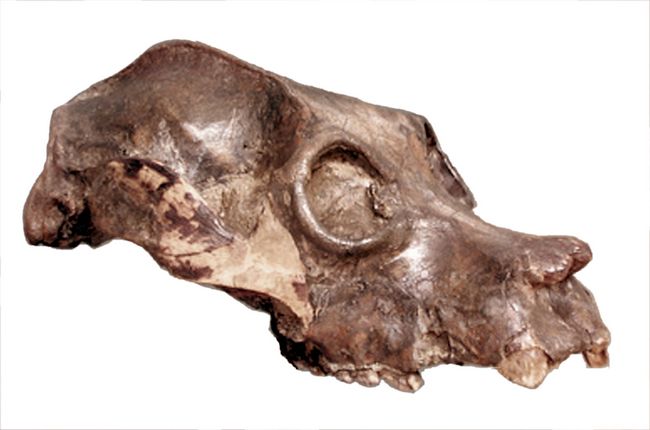 Europe. The type species, N. antiquus (fig.8), was defined in 1873 by Filhol. It is considered distantly ancestral to modern tarsiers.
Europe. The type species, N. antiquus (fig.8), was defined in 1873 by Filhol. It is considered distantly ancestral to modern tarsiers.The body of the adult Necrolemur was 25 cm long and probably resembled that of a tarsier. It was a night hunter and insectivore with sharp teeth, likely used to bite through the tough exoskeletons of insects. Like modern tarsiers, it had a short face, with large eyes and ears and a narrow gap between the eyes, and a relatively large brain. Also like tarsiers, it had long fingers and toes, and a lengthy tail used for balancing in tree climbing.
Fig.8: Skull of Necrolemur antiquus (Mus.Nat Hist.Paris, cast)
Rooneyia
One of the more controversial of all early primate taxa is the Early Oligocene fossil species Rooneyia. which has been alternatively classed as both adapid and omomyid. The tin
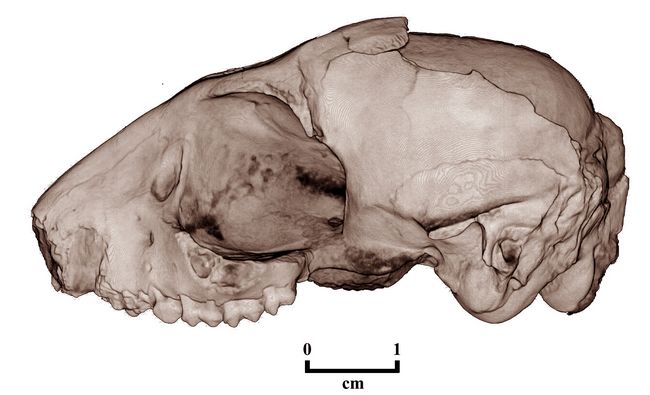 y skull of Rooneyia
was discovered by paleontologist J.A. Wilson in the early 1960s in the Chambers Tuff Formation in the
Sierra Vieja of Trans-Pecos Texas. It is dated from the Earliest
Chadronian phase of the Oligocene, about 35 mya. Together with the late Oligocene Oregonian fossil taxa Ekgmowechashala, Rooneyia is among the latest of primate fossils found in North America.
y skull of Rooneyia
was discovered by paleontologist J.A. Wilson in the early 1960s in the Chambers Tuff Formation in the
Sierra Vieja of Trans-Pecos Texas. It is dated from the Earliest
Chadronian phase of the Oligocene, about 35 mya. Together with the late Oligocene Oregonian fossil taxa Ekgmowechashala, Rooneyia is among the latest of primate fossils found in North America. Fig.9: Skull of Rooneyia viejas (Digimorph; Wilson 1966)
The tiny fossil skull (fig.9) has a unique combination of primitive and derived primate traits which have made its placement problematic. Rooneyia is described by Wilson (1966) as a Lemuriform. Szalay (1976), however, considers it to have more omomyid traits, as the rounded tooth cusps indicate Rooneyia was a fruit eater. Simons (1968), meanwhile, described Rooneyia is a Texan catarrhine, due to similarity of the upper molars to those of Apidium. Unlike the premolars of the Fayum Apidium, as Szalay (1976) points out, those of Rooneyia do not have the enlarged paraconules, and the Texan primate has one less premolar and a relatively smaller canine. The high liklihood of convergent evolution and a mixture of traits in early primates over the long span of their develoopment, which tend to crosscut any strict separation of adapid vs omomyid lines, appear to be well illustrated by Rooneyia.
Ekgmowechashala
Teeth and jaw fragments of Ekgmowechashala macdonald, identified as an omomyid primate, were found in 1965 in Early Arikareean (late Oligocene) strata of South Dakota and Oregon. As such, it is the latest primate species known in North America. The species differs from other omomyids in a number of ways, including having an M1>M2>M3 size relationship, peculiarly flattened molars, and a large molarized fourth premolar. The degree of reduction of the two incisors, coupled with a relatively much larger canine is unique within the Omomyidae. Based on the dentition of the lower teeth, the ancestry of Ekgmowechashala was very likely near the genus Rooneyia. (Szalay 1976).
References:
Beard, K.C. 2008. The oldest North American primate and mammalian biogeography during the Paleocene-Eocene Thermal Maximum. Proceedings of the National Academy of Sciences. 105 (10): 3815–8.
Bernardi, M. and S. Couette, 2017. Eocene Paleoecology of Adapis parisiensis (Primate, Adapidae): From Inner Ear to Lifestyle. The Anatomical Record, vol. 300, no.9, pp. 1576-1588.
Conroy, G.C. 1990. Primate Evolution. W.W. Norton and Co.: New York.
Cray, P.E. 1973. Marsupialia, Insectivora, Primates, Creodonta and Carnivora from the Headon Beds (upper Eocene) of southern England. Bull Br Museum Natural Hist Geol Ser 23: 1– 102.
Cuvier, Georges 1822. Reserches sur les Ossemens Fossiles, Vol. 3 (2nd ed.) Defour et d'Ocagne, Paris.
De Bonis L. 1964. Etude de quelques mammifères du Ludien de la Debruge (Vaucluse). Annales Paléontologie 50: 121– 154.
Delfortrie, E. 1873. Une singe de la famille des lemuriens. Actes.Soc.Linn. Bordeaux 29: 87-95.
Filhol, H. 1874. Nouvelles observations sur les mammifères lémuriens et pachylémuriens. Annales de la société géologique de Paris 5: 1– 36.
Fleagle, J.G. 1988, 1999. Primate Adaptation and Evolution. Academic Press: San Diego.
Franzen, J.L. P.D.. Gingerich , J. Habersetzer, J. Hurum, W. von Koenigswald, and B.H. Smith 2009. Complete Primate Skeleton from the Middle Eocene of Messel in Germany: Morphology and Paleobiology. PLoS One, Vol.4, issue 5.
Gebo, D.L. 2002. Adapiformes: Phylogeny and adaptation . In Hartwig, W.C. (ed.). The Primate Fossil Record. Cambridge University Press.
Gingerich, P.D. 1975. Dentition of Adapis parisiensis and the Evolution of Lemuriform Primates. In Lemur Biology, ed. I. Tattersall and R.W. Sussman. Plenum Press, New York.
Gingerich, P.D. 1977. Dental Variation in early Eocene Teilhardina belgica. Folia Primatologia 28: 144-153.
Gingerich, P.D. 1981. Cranial morphology and adaptations in Eocene Adapidae. I. Sexual dimorphism in Adapis magnus and Adapis parisiensis. Am J Phys Anth 56: 217– 234.
Gingerich, P.D., K.D. Rose, and T. Smith. 2008. Oldest North American Primate. Letter, PNAS vol 105, no. 23.
Godinot M. 1984. Un nouveau genre témoignant de la diversité des Maés (Primates, Adapidae) à l'Eocène terminal. Comptes Rendus l'académie des Sciences, Paris 299: 1291– 1296.
Godinot, M. and M. Dagosto 1983. Astragalus of Necrolemur. Journal of Paleontology, Vol. 57, No. 6, pp. 1321–1324.
Ni, X., Y. Wang, Y. Hu, and C. Li. 2004. A euprimate skull from the early Eocene of China. Nature. 427 (6969):65-68.
Radinsky, L.B. 1970. The Fossil Evidence of Prosimian Brain Evolution. In The Primate Brain. Eds. C.R. Noback and W. Montagna. Appleton-Century-Crofts: New York.
Rosenberger, A.L. 1985. In Favor of the Necrolemur-Tarsier Hypothesis. Folia Primatologica 1985;45:179-194
Simpson, G.G. 1940. Studies on the Earliest Primates. Am Mus.Nat.Hist.Bull.77: 185-212.
Smith, T., K.D. Rose, and P.D. Gingerich 2006. Rapid Asia-Europe-North America geographic dispersal of earliest Eocene primate Teilhardina during the Paleocene-Eocene Thermal Maximum. Proceedings of the National Academy of Sciences. 103 (30): 11223–7.
Stehlin H.G. 1912. Die Säugetiere des schweizerischen Eocaens. Siebenter Teil, erste Hälfte Adapis. Abhandlungen der Schweizerichen Paläontologischen Gesellschaft 38: 1163– 1298.
Szalay, F.S. 1976. Systematics of the Omomyidae (Tarsiiformes, Primates): Taxonomy, phylogeny, and adaptations. Bulletin of the american Museum of Natural History 156
Szalay, F.S and E. Delson 1979. Evolutionary history of the primates. New York: Academic Press.
Wilson, J.A. 1966. A new primate from the earliest Oligocene, west Texas, preliminary report. Folia Primatologica, 4
Wilson, J.A. and F.S. Szalay 1976. New Adapid Primate of European Affinities from Texas. Folia Primatologica 25:294-312
Glossary